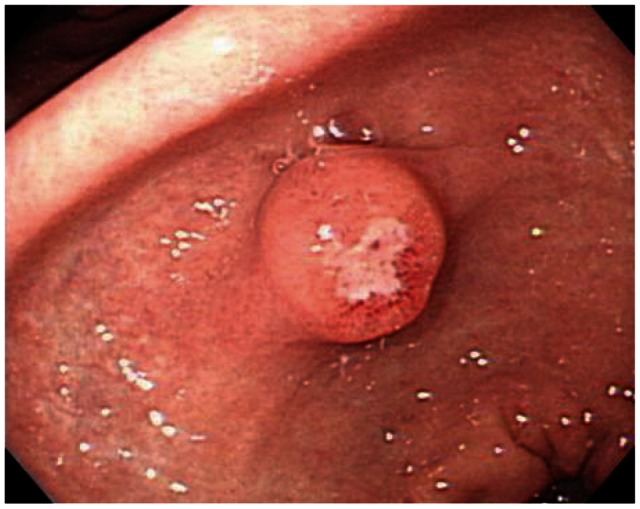Clin Endosc.
2013 May;46(3):243-247. 10.5946/ce.2013.46.3.243.
Gastric Polyps and Protruding Type Gastric Cancer
- Affiliations
-
- 1Department of Internal Medicine, Catholic University of Daegu School of Medicine, Daegu, Korea. jungjt@cu.ac.kr
- KMID: 2048928
- DOI: http://doi.org/10.5946/ce.2013.46.3.243
Abstract
- Gastric protruding lesions are frequently encountered by health screening esophagogastroduodenoscopy. They can be classified into epithelial lesion and subepithelial lesion. Epithelial gastric lesions are generally divided into benign and malignant. Benign lesions include some types of polyps, i.e., hyperplastic polyp, fundic gland polyp, and gastric adenoma. Malignant lesions include carcinoid, early gastric cancer and advanced gastric cancer. They can be accurately diagnosed by magnifying endoscopy or narrow band imaging. Here, I will discuss benign and malignant epithelial lesions of the stomach.
MeSH Terms
Figure
Reference
-
1. Dekker W. Clinical relevance of gastric and duodenal polyps. Scand J Gastroenterol Suppl. 1990; 178:7–12. PMID: 2277971.
Article2. Stolte M, Sticht T, Eidt S, Ebert D, Finkenzeller G. Frequency, location, and age and sex distribution of various types of gastric polyp. Endoscopy. 1994; 26:659–665. PMID: 7859674.
Article3. Park do Y, Lauwers GY. Gastric polyps: classification and management. Arch Pathol Lab Med. 2008; 132:633–640. PMID: 18384215.
Article4. Abraham SC, Singh VK, Yardley JH, Wu TT. Hyperplastic polyps of the stomach: associations with histologic patterns of gastritis and gastric atrophy. Am J Surg Pathol. 2001; 25:500–507. PMID: 11257625.
Article5. Lim SA, Yun JW, Yoon D, et al. Regression of hyperplastic gastric polyp after Helicobacter pylori eradication. Korean J Gastrointest Endosc. 2011; 42:74–82.6. Ji F, Wang ZW, Ning JW, Wang QY, Chen JY, Li YM. Effect of drug treatment on hyperplastic gastric polyps infected with Helicobacter pylori: a randomized, controlled trial. World J Gastroenterol. 2006; 12:1770–1773. PMID: 16586550.
Article7. Hattori T. Morphological range of hyperplastic polyps and carcinomas arising in hyperplastic polyps of the stomach. J Clin Pathol. 1985; 38:622–630. PMID: 4008664.
Article8. Kang HM, Oh TH, Seo JY, et al. Clinical factors predicting for neoplastic transformation of gastric hyperplastic polyps. Korean J Gastroenterol. 2011; 58:184–189. PMID: 22042418.
Article9. Vanek J. Gastric submucosal granuloma with eosinophilic infiltration. Am J Pathol. 1949; 25:397–411. PMID: 18127133.10. Elster K. Histologic classification of gastric polyps. Curr Top Pathol. 1976; 63:77–93. PMID: 795617.
Article11. Torbenson M, Lee JH, Cruz-Correa M, et al. Sporadic fundic gland polyposis: a clinical, histological, and molecular analysis. Mod Pathol. 2002; 15:718–723. PMID: 12118109.
Article12. Hofgartner WT, Thorp M, Ramus MW, et al. Gastric adenocarcinoma associated with fundic gland polyps in a patient with attenuated familial adenomatous polyposis. Am J Gastroenterol. 1999; 94:2275–2281. PMID: 10445562.13. Zwick A, Munir M, Ryan CK, et al. Gastric adenocarcinoma and dysplasia in fundic gland polyps of a patient with attenuated adenomatous polyposis coli. Gastroenterology. 1997; 113:659–663. PMID: 9247488.
Article14. Bertoni G, Sassatelli R, Nigrisoli E, et al. Dysplastic changes in gastric fundic gland polyps of patients with familial adenomatous polyposis. Ital J Gastroenterol Hepatol. 1999; 31:192–197. PMID: 10379478.15. Jung A, Vieth M, Maier O, Stolte M. Fundic gland polyps (Elster's cysts) of the gastric mucosa. A marker for colorectal epithelial neoplasia? Pathol Res Pract. 2002; 198:731–734. PMID: 12530575.
Article16. Jalving M, Koornstra JJ, Wesseling J, Boezen HM, DE Jong S, Kleibeuker JH. Increased risk of fundic gland polyps during long-term proton pump inhibitor therapy. Aliment Pharmacol Ther. 2006; 24:1341–1348. PMID: 17059515.
Article17. Camilleri JP, Poter F, Amat C. Gastric mucosal dysplasia: preliminary results of a prospective study of patients followed for periods of up to six years. In : Ming SC, editor. Precursors of Gastric Cancer. New York: Praeger;1984. p. 83–92.18. de Vries AC, van Grieken NC, Looman CW, et al. Gastric cancer risk in patients with premalignant gastric lesions: a nationwide cohort study in the Netherlands. Gastroenterology. 2008; 134:945–952. PMID: 18395075.
Article19. Capella C, Solcia E, Sobin LH, Arnold R. Aaltonen LA, Hamilton SR, editors. World Health Organization. International Agency for Research on Cancer. Endocrine tumors of the stomach. Lyon: IARC Press;2000. p. 53–56.20. Caplin ME, Buscombe JR, Hilson AJ, Jones AL, Watkinson AF, Burroughs AK. Carcinoid tumour. Lancet. 1998; 352:799–805. PMID: 9737302.
Article21. Rindi G, Luinetti O, Cornaggia M, Capella C, Solcia E. Three subtypes of gastric argyrophil carcinoid and the gastric neuroendocrine carcinoma: a clinicopathologic study. Gastroenterology. 1993; 104:994–1006. PMID: 7681798.
Article22. Park SJ. Benign and malignant lesion of stomach. Korean J Gastrointest Endosc. 2008; 36(Suppl 1):60–66.23. Yang CH. Benign and malignant lesion of gastric protruding mass. Korean J Gastrointest Endosc. 2007; 35(Suppl 1):34–44.24. Chonan A, Mochizuki F, Fujita N, et al. Gastric cancer resembling submucosal tumor. Endoscopic diagnosis of gastric cancer similar to submucosal tumors. Stomach Intest. 1995; 30:777–785.25. Lee JH. Gastric cancer mimicking submucosal lesions. The 46th Seminar of Korean Society of Gastrointestinal Endoscopy. 2012. 2012 March 25; Goyang, Korea. Seoul: Korean Society of Gastrointestinal Endoscopy;p. 85–87.
- Full Text Links
- Actions
-
Cited
- CITED
-
- Close
- Share
- Similar articles
-
- Gastric Polyp: Is It Serious?
- Clinicopathologic Evaluation of Gastric Polyps Remainding in the Stomach after a Gastrectomy
- Diffuse-type Gastric Cancer
- The Comparative Immunohistochemical Study of Carcinoembryonic Antigen(CEA) by Immunoperoxidase Method Between Polyps and Adenocarcinoma of the Stomach
- Helicobacter pylori Eradication and Gastric Cancer Prevention




